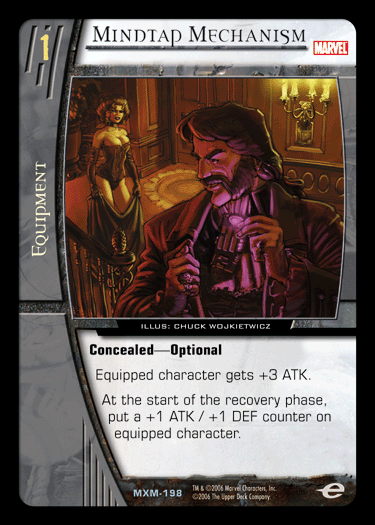
Mike became a proud father on Friday with the birth of his baby daughter. Congrats, Mike! - TW
First, let’s start with the preview:

Next, let’s follow up with the boxtopper rules for equipment with concealed—optional:
- You can equip hidden characters (as well as visible characters) with this card; and
- This card is not put into your KO’d pile as the equipped character moves between areas.
Our story of concealed—optional equipment cards begins with the Marvel Knights set and the introduction of the concealed mechanic. During the development of the new mechanic, it was discovered that certain pieces of equipment that had already been designed were simply too powerful if played on a hidden character. Cards like Flamethrower were balanced against the equipped character being vulnerable to an opponent’s attacks.
In the end, we needed to incorporate rules into the concealed mechanic that prevented hidden characters from being equipped and equipment from entering the hidden area. While this fixed legacy issues with existing cards, it also cut off future design space. Understanding the interaction between concealed and visible characters, we could create new pieces of equipment that were balanced against being played in either area.
Our first piece of equipment that worked with hidden characters was Medallion of Power. To overcome the restrictions of the concealed mechanic, the Medallion needed the wording, “Equip Medallion of Power only to a hidden character,” and, “Medallion of Power is not KO’d as equipped character moves to a different area.” This templating required two lines of game text to overcome the keyword’s restrictions. This unfortunately took up a lot of text box space and led to us needing to make the text of the equipment game effect short. This didn’t seem like the optimal solution if we wanted to make more concealed-centric equipment cards in the future.
Jumping ahead to the Green Lantern set, we introduced the concealed—optional mechanic for characters. One of the goals for this mechanic was to offer players a strategic choice of where to recruit the character. This gave us a single keyword that captured all the rules for allowing a player to recruit the character into either area.
That brings us to the middle of the X-Men development cycle. By this time, the mechanical identity of the Hellfire Club team had been established. One of the team’s primary play patterns focused on manipulating the number of hidden and visible characters a player controlled. It was at this point that David Humpherys suggested that we go back and re-evaluate the design of equipment cards that could be played on characters in the hidden area and wouldn’t fall off when moved between the areas.
Using the concealed—optional rules for characters as the baseline, we updated the keyword specifically for equipment and solved our lengthy templating problem. Unlike Medallion of Power, we decided that concealed–—optional equipment should, as a default, be allowed to be recruited on characters in either area instead of just on hidden characters.
Mindtap Mechanism’s effect plays directly into the strength of a concealed character. A concealed character has the ability to pick and choose when it will get into a fight. During early turns, a concealed character with the Mechanism can choose to attack safe targets, helping to ensure that it is not stunned at the start of the recovery phase. As the character begins to grow over time, it can start to attack larger targets. The Mechanism is even more deadly when equipped to a Hellfire Club character, as the team is supported by effects that easily allow them to move in and out of the hidden area.
Be sure to look for more concealed—optional equipment in the future, and come back tomorrow for our next preview.
Tomorrow's Preview: